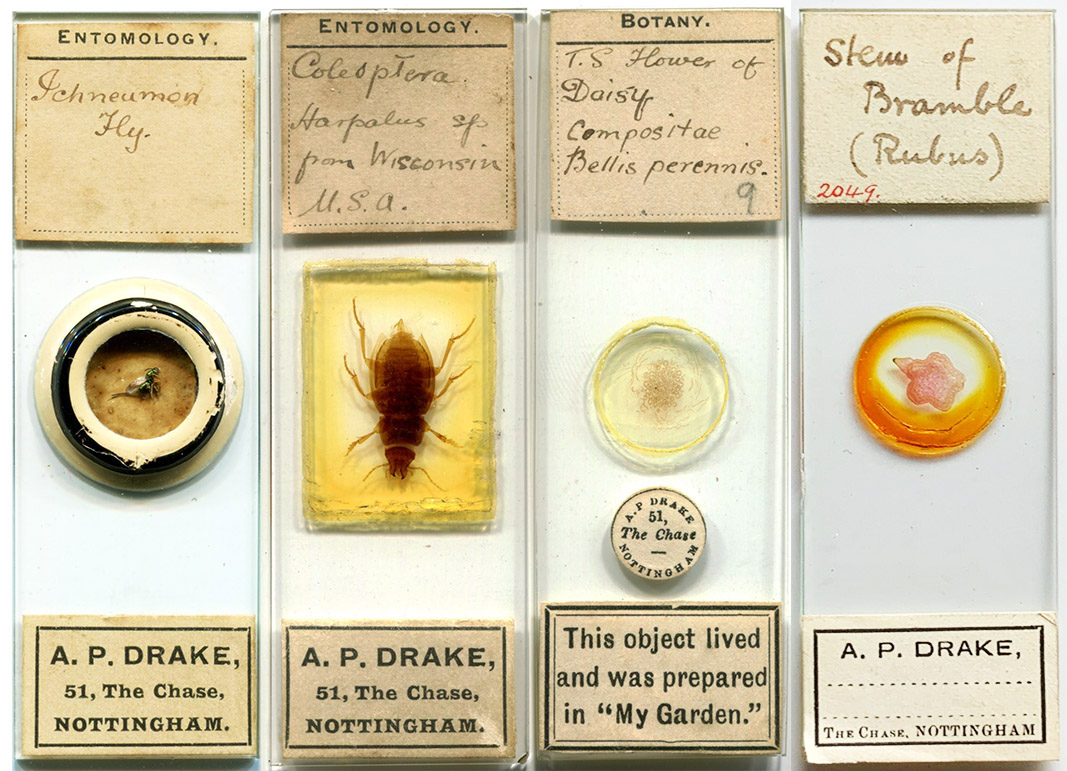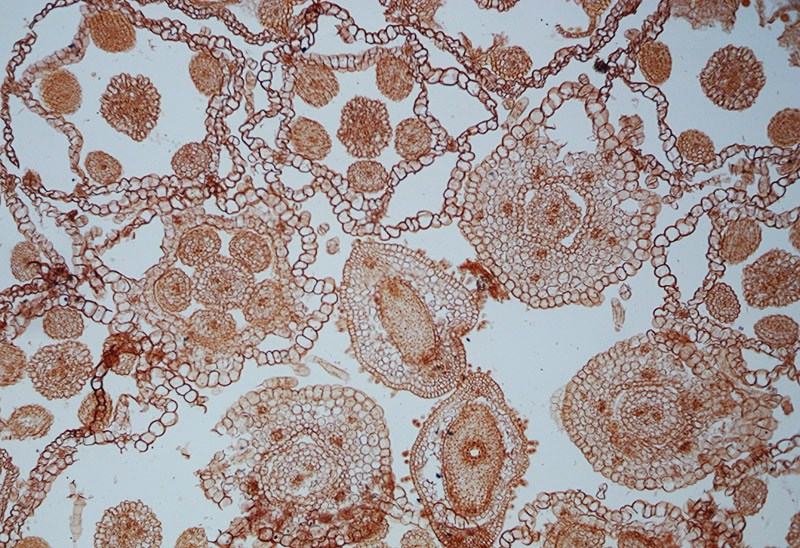Arthur Penrhyn Drake, 1877- 1967
by Brian Stevenson
last updated June, 2025
A.P. Drake was an electrical and mechanical engineer, and a hobby microscopist. During late 1916 – early 1917, Drake acquired a substantial portion of the trade stock of professional slide-maker James Bertram Howard. Soon afterward, Drake advertised Howard’s slides for sale, along with “new and secondhand” slides. The new slides were prepared by Drake himself. Slides with Drake’s address label and dates from the late 1800s are known, evidently the “secondhand” slides in his possession. All slides known to have been made or sold by A.P. Drake carry the address “51 The Chase, Nottingham”, where he lived between ca. 1917 and ca. 1927. He advertised slides for sale in The English Mechanic and World of Science from 1917 until early 1919. It is not clear whether he continued to sell slides after that date. Hubert J. Gray began selling microscope slides in about 1919, a number of which were preparations by Drake or Howard, raising the possibility that Drake sold his stock to Gray.

Figure 1.
Microscope slides that were prepared by Arthur P. Drake. He lived at 51 The Chase (also known as Robin Hood Chase), Nottingham, between ca. 1917 and ca. 1927, and is known to have sold slides between 1917 and early 1919. During that time, Drake also sold slides that had been prepared by J.B. Howard.

Figure 2.
Transverse section of the flower of a daisy, Bellis perennis, prepared ca. 1918 by A.P. Drake (see Figure 1). Photographed with a C-mounted digital SLR camera on a Leitz Ortholux II microscope, with a 10x objective lens and blue filter.

Figure 3.
Advertisements relating to A.P. Drake’s microscope sales, all from ‘The English Mechanic and World of Science’.
A. November 17, 1916, advertisement from J.B. Howard, seeking to unload his stock of “thousands” of slides. This was probably when he learned that he was being drafted into the Army. In February, 1917, his employer appealed that Howard performed essential medical duties in England, but he was drafted that spring, nonetheless.
B. January 25, 1918, advertisement from A.P. Drake, offering Howard’s slides and “anything microscopical”.
C. March 8, 1918.
D. January 17, 1919. A similar advertisement in the February 21, 1919, issue is the last known indication of Drake’s retail business. Drake’s advertisements generally read “please state requirements” or “no lists”, suggesting that he mounted random objects or custom orders, but did not keep a wide stock of his own preparations. His specific description of slides by Howard indicates that Drake sold them with their original labels, and suggests that many surviving Howard slides came through Drake
Arthur Penrhyn Drake was born on January 18, 1877, evidently the first child of James and Elizabeth (Seanor) Drake of 634 Wakefield Road, Bradford, Yorkshire. In Britain at that time, it was customary to name the first son after his paternal grandfather, but neither “Arthur” nor “Penrhyn” appear to be family names. Instead, our microscopist may have been named after the Reverend Arthur Penrhyn Stanley (1815-1881), Dean of Westminster and a noted clergyman.
Arthur lived with his parents until after their deaths. It is not clear whether he married (he was not married at the time of the 1911 census). Father James was a “stone mason” (1881 census) and “clerk of works” (1901 census), who died in 1909. Mother Elizabeth died in 1917.
Drake’s 1906 application for membership in the Institution of Mechanical Engineers provided details of his schooling and work experience up to that time. He attended Bradford Technical College from 1891 until 1898, for two years a day student and 5 years a night student. He apprenticed with Andrews and Preece electrical engineers from 1893-1896, then Rosling, Appleby, and Fyn electrical and mechanical engineers from 1896-1900. He then worked until 1903 “on own account as Elect. & Mech. Engineer & Brassfounder, the principal work being erection & maintenance of house lighting plants, instruments for schools, etc. & plumbers & other brass work”. He then took charge of the factory of Kynochs Explosive Works in Kynochtown, Essex until 1904, then served as an inspector for the British Engine, Boiler and Electrical Insurance Company, Manchester.
The 1907 list of members of the Institution of Electrical Engineers recorded Arthur as living at 33 Shrewsbury Road, Sheffield. The 1911 census listed him as living with his mother and sister Edith at 83 Ingram Road, Sheffield. Arthur then reported that he continued to work as an “electrical engineering inspector”. Drake joined the Quekett Microscopical Club on November 23, 1915, and the 1916 list of QMC members states that he still lived at 83 Ingram Road.
He moved to 51 The Chase, Nottingham circa 1917. This may have coincided with the death of his mother that year.
James B. Howard, a trainee pharmacist/chemist of Richmond, Yorkshire, operated a side business of making and selling microscope slides. During World War I, Howard served in India with the Royal Army Medical Corps. Just before his departure from England, Howard sold off thousands of his slides at cut-rate prices in late 1916 (Figure 3A). Arthur Drake purchased many, possibly all, of Howard’s slides, then began re-selling them. At the same time, 1917-1919, Drake also advertised to sell slides of his own make (Figures 1, 2 and 3B-D). He also sold used slides, to which he attached his address label. Drake-labeled slides that bear dates from the 1800s, or have labels written in a different hand, are undoubtedly his secondhand sales.
Drake did not advertise slide sales in The English Mechanic and World of Knowledge after February, 1919. I have not located advertisements in any other magazines. The apparently short run of his business suggests that it consisted primarily of selling off Howard’s slides that Drake did not want to keep, plus unloading unwanted slides he had acquired over the years along with some selling of his own creations. Evidence indicates that Drake was reasonably successful at his engineering job. While re-selling the Howard slides probably yielded a nice profit, it appears that manufacturing and selling his own slides was not worth the effort to pursue for long.
Nonetheless, Arthur Drake continued with his interests in microscopy. He remained a member of the Quekett Microscopical Club through at least 1927. He was not included in the 1933 list of members. Drake also joined the Royal Microscopical Society, in 1923. He may have shared his slides with fellow club members.
The 1925 Nottingham City Directory lists Drake as still living at 51 Robin Hood Chase. The 1927 list of QMC members records him at “St. Winnow”, 49 Blythe Street, Nottingham. All Drake-labeled slides with which I am familiar bear the Chase address, indicate sale/manufacture before ca. 1927.
A.P. Drake died on April 30, 1967, in Newton Abbot, Devon.
Resources
Bracegirdle, Brian (1998) Microscopical Mounts and Mounters, Quekett Microscopical Club, London, pages 32, 54, 128, and 146, and Plates 12-R, 12-S, 21-K, 21-L, and 21-M
The Colliery Guardian and Journal of the Coal and Iron Trades (1928) “A paper was read by Mr. A. P. Drake, A.M.I.E.E., entitled ‘Electrical Breakdowns - Grave and Gay’,” Vol. 136, page 1367
England census and birth records, accessed through ancestry.com
English Mechanic and World of Science (1916) Advertisements from J.B. Howard, Vol. 104, pages 279 and 339
English Mechanic and World of Science (1918) Advertisements from A.P. Drake, Vol. 106, pages 12, 34, and 82
English Mechanic and World of Science (1919) Advertisements from A.P. Drake, Vol. 109, page 12
Garcke's Manual of Electricity Supply (1928) “Drake, Arthur Penrhyn, A.M.I.E.E., A.M.I. Mech.E., F.R.M.S., 49 Blythe Street, Nottingham”, Vol. 32, page 1685
The Institution of Mechanical Engineers (1906) Application for membership of A.P. Drake, accessed through ancestry.com
Journal of the Quekett Microscopical Club (1915) November 23, 1915 meeting: “Geo. W. King, John Geo. Bradbury and Arthur P. Drake were balloted for, and duly elected members of the Club”
Journal of the Quekett Microscopical Club, Vols. 1-36, 1868-1992, CD-ROM edition 1998, second printing 2003
The Model Engineer and Practical Electrician (1902) “The Bradford Branch had an exhibition night on March 3rd, 1902. The following models were shown: … Mr. Drake, a piston valve engine, 1 in. by 1 1/2 ins. stroke; also a tender for a locomotive of S.E. & C.R., 3 1/8 ins gauge … The usual fortnightly meeting of the Bradford Branch was held on March 17th, 1902, at the Coffee Tavern, Tyrrell Street, Bradford. Mr. A.P. Drake presided, and after formal business Mr. Drake showed a Skinner engine”, Vol. 6, page 171
Nottingham City Directory (1925) “Drake Arthur Penrhyn, engineer surveyor, 51 Robin Hood’s chase”, page 457
Probate of the will of Arthur P. Drake (1967) "Drake Arthur Penrhyn of The Firs Livingstone Road Teignmouth Devon died 30 April 1967 at Newton Abbot Hospital Devon Probate Exeter 24 May to George McClure retired brewery engineer and Charles Bigwood Gunstone retired engineer surveyor. £6072", accessed through ancestry.com
Seanor/Waddington/Rhodes Family Tree, which includes A.P. Drake (accessed August, 2016) http://person.ancestry.co.uk/tree/15067734/person/28083679405/facts
UK Electrical Engineer Lists (1930) “Drake, Arthur Penrhyn, 49 Blythe Street, Nottingham”, page 109


